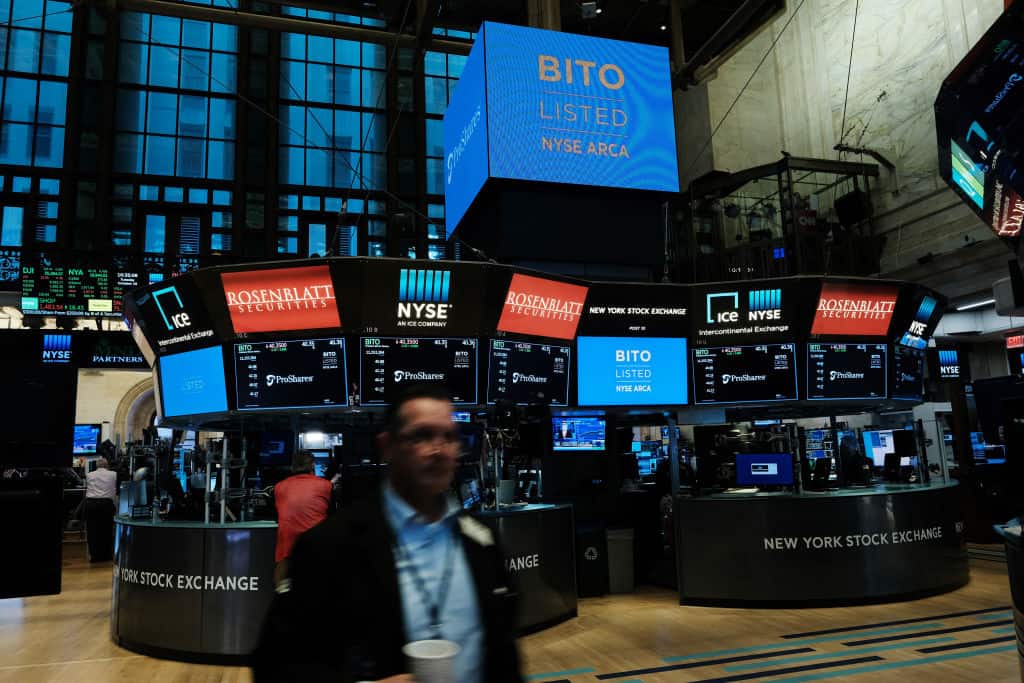Bitcoin’s price smashed through its previous all time high and is trading above US$67,000 at press time, according to Coingecko. This is the second time Bitcoin has peaked this year — in April it set a record when it reached US$64,804.72.
The record-breaking rally comes one day after the New York Stock Exchange began trading the first U.S. Bitcoin futures exchange-traded fund (ETF), after the Securities and Exchange Commission on Friday had cleared the registration of ProShares Bitcoin Strategy ETF.
This year’s price rallies have been driven by a host of good tidings and increasing adoption, according to Jonathon Miller, Australia managing director for digital asset exchange Kraken. Bitcoin’s April high was driven by booming institutional interest in the space. From Visa to PayPal and from Budweiser to CocaCola, companies are embracing crypto and launching related products, including non-fungible tokens.
Moreover, El Salvador’s adoption of Bitcoin as legal tender has created an opening for other countries to regulate cryptocurrencies. This momentum, dovetailing with soaring crypto adoption, has led to a rise in cryptocurrency awareness as well as regulatory scrutiny. Bitcoin’s all-time high is a “confluence” of these developments, Miller added.
The crypto world’s excitement about the launch of the first Bitcoin futures ETF accelerated the Bitcoin price rally that began earlier this month when SEC Chairman Gary Gensler said that he had no plans of banning crypto.
The cause behind the effect
ProShares ETF had a wildly successful debut on Tuesday. Within the first 20 minutes of launch, investors traded around US$280 millions’ worth of ProShares.
By the end of the trading day, volume had reached nearly US$1 billion with more than 20 million shares traded, according to Bloomberg data. ProShares is only the second fund to reach such massive trading volume on the first day, after BlackRock’s Carbon Transition Readiness sustainable ETF. ProShares opened with an initial share price of US$40 which peaked to US$42.15 during the day and closed at US$41.94, an increase of 4.85%.
While the high trading volume was significant for an ETF, it was less notable when compared to daily trading volumes on large crypto exchanges, Miller said. “It sounds like a lot of money, and it’s a good first day. But to put it in context, exchanges, even like our own Kraken, are trading over a billion dollars a day on the spot markets,” Miller said.
Tony Sycamore, financial markets analyst APAC at City Index, told Forkast.News that the spectacular performance of ProShares reflects “enthusiasm from a broader set of investors which are now more comfortable investing in digital assets.”
There are certain drawbacks to trading ProShares, however. Investors are restricted to the operating hours of the NYSE — trades can only be executed during the seven hours of NYSE operations each weekday, minus holidays. “What we’re looking at here is a very volatile asset class [cryptocurrencies]. They can move on the weekends, they can move at any time …. And where there may be some limitations to the Bitcoin-futures ETF is that it doesn’t allow investors to capitalize on those big moves that occur outside of exchange trading hours,” Sycamore said.
Besides, investing in ProShares is not like investing in Bitcoin itself, which is why Sycamore calls it a “derivative of a derivative.” He said: “If you think about it, a futures contract is a derivative of the underlying asset, and an ETF is a derivative of a derivative.” Currently, there are around four more futures ETFs that are awaiting launch in the U.S., with some expecting the Valkyrie Bitcoin Strategy ETF to go live also by this week on the Nasdaq.
Sycamore believes that although futures ETFs will attract a broad range of investors, crypto investor appetite is now whetted towards investing in actual cryptocurrencies. This could either be achieved by trading on an unregulated crypto exchange or through a Bitcoin spot derivative.
Attempts have been made earlier to get the SEC’s nod for spot ETFs, but the approval of a futures derivative has made it more likely the SEC will approve spot derivatives in the future, Sycamore said.
Grayscale on Tuesday filed with the SEC to convert its Bitcoin Trust fund into a Bitcoin spot ETF. While it may become the first spot ETF if approved, Sycamore believes it will not happen quickly. “It’s definitely easier to get Bitcoin Spot ETF now that the Bitcoin Futures ETF has been launched, because once you open the door, it’s always easier to push it a little bit further open. But I don’t think the regulators are in any rush,” Sycamore said.
Miller agreed that there is a good chance that a Bitcoin Spot ETF will now be approved, but said, “It could go either way.” The concern for the SEC lies in the fact that crypto exchanges are not regulated, unlike the Chicago Mercantile Exchange, where Bitcoin-futures contracts are traded, Miller said.
A Bitcoin futures ETF has extra layers of regulation. The futures market is regulated by the Commodity Futures Trading Commission and ETFs are regulated by the SEC. Moreover, the futures contracts are trading on the CME while shares of futures ETFs are being traded on NYSE — both are regulated exchanges. This is what makes the SEC more comfortable granting approval to crypto futures ETFs compared to spot ETFs, both Sycamore and Miller said.
Every Bitcoin bull run, however, is inevitably followed by a pullback where investors cash in on profits. Bitcoin’s price dips during these corrections have been narrowing over the last few years. It remains to be seen how much it will dip this time.
Sycamore told Forkast.News that December has in recent years been an eventful month for Bitcoin. In December 2017, Bitcoin set a record by stopping just short of US$20,000. In December 2018, Bitcoin prices plunged below US$4,000. In December 2020, it topped its 2017 record and the bull run continued well into this year.
Sycamore said he is not certain which way the scales will tip this December, but he is keeping watch.





